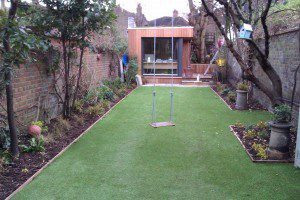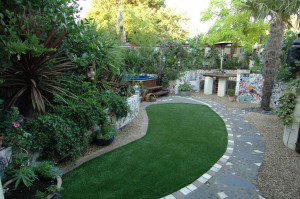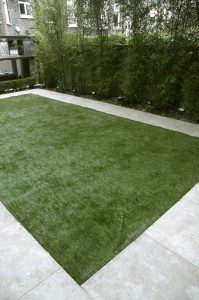Garden Design Top Tips: I Fought the Lawn…

When I was young, many moons ago, artificial grass was crude stuff, with an appearance similar to the green matting greengrocers use to cover their display tables. We had an ‘all-weather’ pitch at my school and I remember the ‘grass’ as nasty, scratchy, unnaturally day-glo stuff which gave you terrible friction burns every time you were tackled. While this stuff still exists at the budget end of the scale, the manufacturing technology has improved markedly in the past 30 years, and it is possible to buy artificial lawn that is virtually indistinguishable from the real thing (unless you get down on your hands and knees and really inspect it up close).
If you are thinking of renewing a tired or dead lawn, you may want to consider artificial grass as a replacement. While it is more expensive than real turf per square metre, it has many advantages which make it a worthwhile investment:
- It never needs mowing
- It never needs watering (no more watching your lawn wither during a hosepipe ban in hot summer months)
- It stays looking green and lush all year round
- It’s virtually maintenance free, unlike real lawn which is one of the most high maintenance things you can have in a garden
- It will last for at least 10 years (and should last much longer)
- It is easy to install for an average diy-er (most suppliers can provide detailed laying instructions)
- It is child and pet friendly
There are many companies out there selling artificial turf, as a quick Google search will confirm. We have used quite a few of them over the years, and have found that they all provide good quality, realistic turf. If you really want to turn the Jones’s green with envy at your perfect looking lawn, opt for a high end, luxury variety. This will often have a mixture of blades in 2 or 3 different shades and lengths, with a short, curled pile underneath to simulate dead grass that you would find in a real lawn.
Most artificial lawn suppliers have an installation service, but if you are laying the lawn yourself try to buy a variety that doesn’t need a sand or rubber infill. Some varieties require you to spread dry sand or rubber pellets across the freshly laid lawn, to weigh the grass down and make the individual blades stand upright. If you are inexperienced you can end up with a patchy appearance which can take months to settle down.



